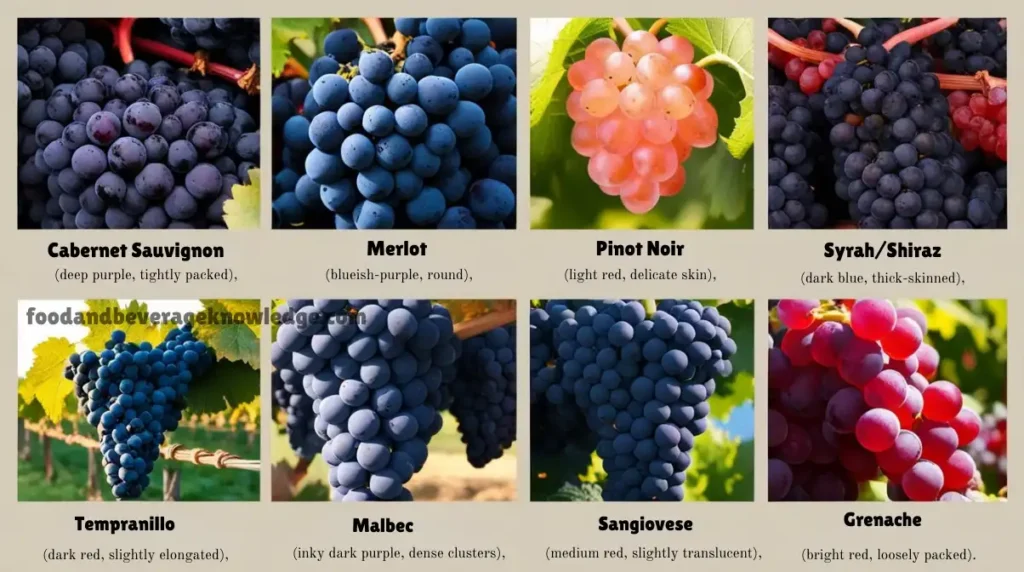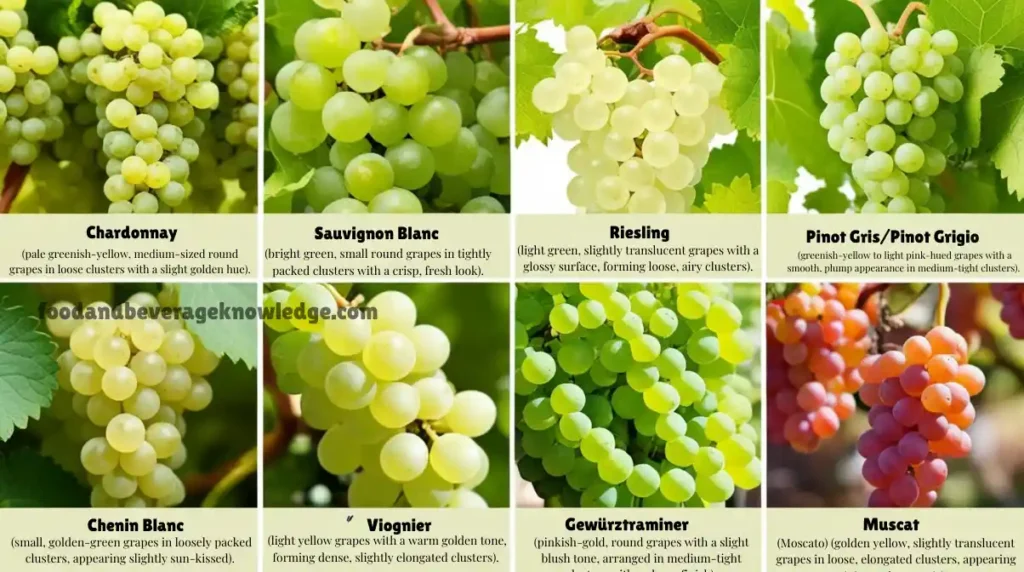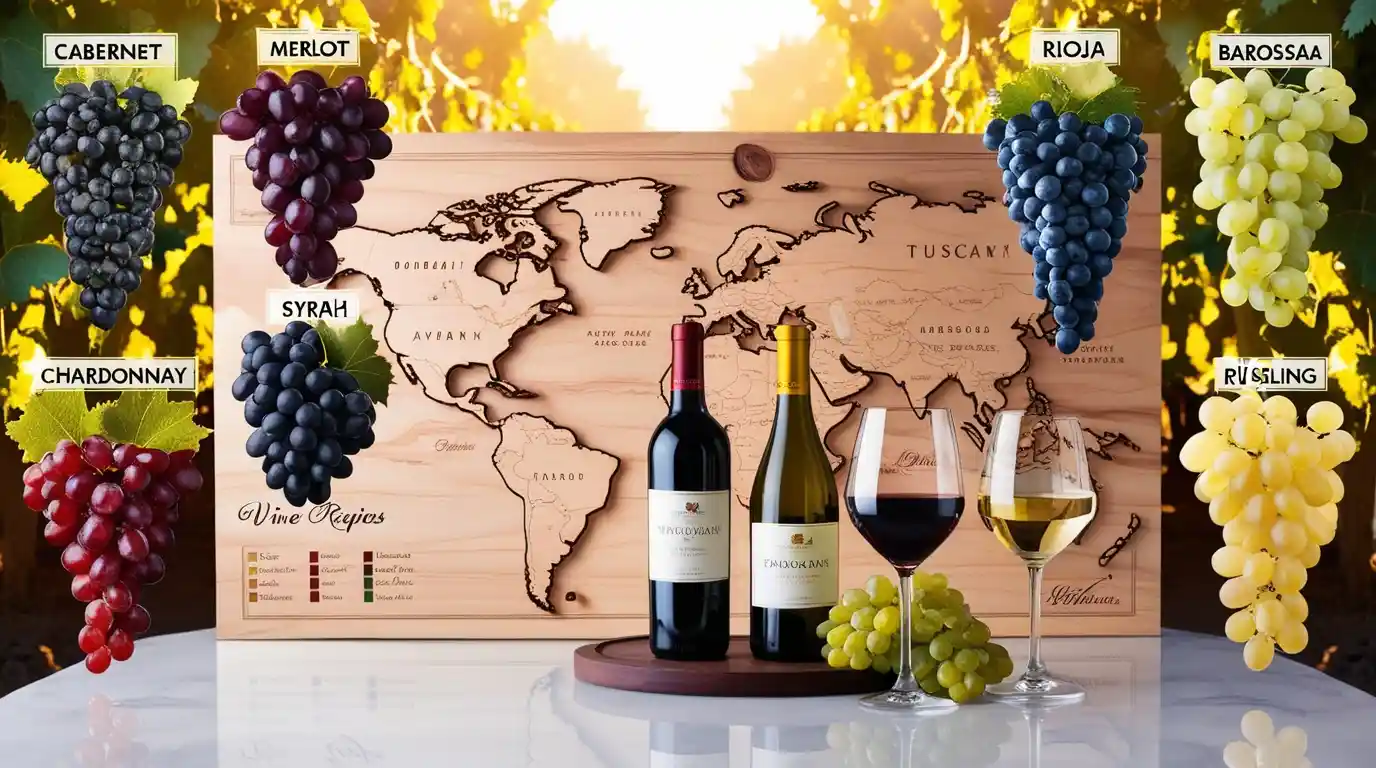Wine is one of the oldest and most celebrated beverages in human history. The foundation of great wine lies in the grapes used in its production. While thousands of grape varieties exist, only a select few dominate the global wine industry. These grape varieties influence the wine’s flavour, aroma, colour, and ageing potential.
Table Grapes vs. Wine Grapes: Key Differences
- Skin & Structure: Wine grapes have thicker skins, adding tannins and colour; table grapes have thinner skins for easy eating.
- Size & Sugar: Wine grapes are smaller and have higher sugar for fermentation; table grapes are larger and juicier.
- Seeds & Acidity: Wine grapes often have seeds and higher acidity; table grapes are usually seedless and milder.
- Purpose: Wine grapes are grown for winemaking, and harvested at peak ripeness; table grapes are for fresh eating, picked earlier for crispness.
This article explores 16 of the most widely used wine grape varieties, divided into red and white categories, and highlights their key characteristics, primary growing regions, and the wines they are mostly used for. Whether you are a casual wine enthusiast or a serious connoisseur, this guide will help you understand the grapes that shape the world of wine.
Related: The Ultimate Guide to Wine Types: Exploring Varieties, Styles, and Characteristics
Red Grape Varieties

1. Cabernet Sauvignon
Cabernet Sauvignon is a full-bodied, dry red wine grape known for its rich structure and deep flavors. It thrives in diverse climates, allowing for complex expressions in different regions. Its bold character and ageing potential make it a favourite among wine enthusiasts.
Flavours: Black currant, blackberry, cedar, tobacco, spice, and vanilla (when aged in oak).
Mostly Used In: Bordeaux blends, Napa Valley Cabernet, Super Tuscans
Primary Growing Regions:
- France: Bordeaux (Left Bank)
- USA: Napa Valley, Sonoma
- Australia: Coonawarra, Margaret River
- Chile, Argentina, South Africa
2. Merlot
Merlot is a smooth, medium to full-bodied dry red wine grape, cherished for its velvety texture and ripe fruit flavours. With softer tannins and an approachable character, it appeals to both new and seasoned wine lovers. Its adaptability allows it to shine as a standalone varietal or as a key component in world-class blends.
Flavours: Plum, cherry, chocolate, vanilla, and mocha.
Mostly Used In: Bordeaux blends, Merlot varietals, Right Bank Bordeaux wines
Primary Growing Regions:
- France: Bordeaux (Right Bank – Pomerol, Saint-Émilion)
- USA: California, Washington
- Italy, Chile, Argentina
3. Pinot Noir
It is a light to medium-bodied, dry red wine grape known for its delicate structure and bright acidity. It thrives in cooler climates, producing elegant wines with complex aromas. Its finesse and versatility
Flavours: Strawberry, cherry, raspberry, floral, earthy, and mushroom notes.
Mostly Used In: Burgundy wines, Champagne, Oregon Pinot Noir
Primary Growing Regions:
- France: Burgundy, Champagne
- USA: Oregon, California
- New Zealand, Germany
Also Read: 19 Popular Wine and Cheese Pairings: Matching Reds, Whites, and More
4. Syrah (Shiraz)
Syrah (Shiraz) is a powerful, full-bodied dry red wine grape, celebrated for its deep colour and bold, complex flavours. Its style varies from the peppery, structured wines of the Rhône Valley to the rich, fruit-driven expressions of Australia. With firm tannins and excellent ageing potential, it remains a favourite among those who enjoy intense, expressive reds.”
Flavours: Blackberry, blueberry, pepper, violet, smoky, and chocolate.
Mostly Used In: Rhône wines, Australian Shiraz, Syrah blends
Primary Growing Regions:
- France: Rhône Valley
- Australia: Barossa Valley, McLaren Vale
- USA, South Africa
5. Tempranillo
Tempranillo is a dry, medium to full-bodied red wine grape that defines Spain’s most renowned wines. With a perfect balance of acidity and tannins, it evolves beautifully over time, gaining depth and complexity. From vibrant young styles to elegantly aged, oak-matured classics, it showcases remarkable versatility.
Flavours: Cherry, plum, leather, tobacco, vanilla, and dried fig.
Mostly Used In: Rioja wines, Ribera del Duero wines, Spanish blends
Primary Growing Regions:
- Spain: Rioja, Ribera del Duero
- Portugal, Argentina
6. Malbec
Originally from France but now synonymous with Argentina, Malbec wines are bold and smooth. Malbec is a full-bodied, dry red wine grape known for its deep color and rich, velvety texture. It offers bold fruit flavours with smooth tannins, making it highly approachable. Originally from France, it thrives in Argentina, producing some of the world’s most celebrated Malbec wines.
Flavours: Black plum, dark chocolate, blackberry, and coffee.
Mostly Used In: Argentine Malbec, Cahors wines
Primary Growing Regions:
- Argentina: Mendoza
- France: Cahors
- Chile, USA
7. Sangiovese
Sangiovese is a dry, medium to full-bodied red grape that serves as the foundation for many iconic Italian wines. Known for its bright red fruit flavours, firm tannins, and high acidity, it develops complexity with age. Its earthy and savoury undertones make it a versatile pairing for a wide range of dishes.”
Flavours: Red cherry, dried herbs, tomato, leather, and tobacco.
Mostly Used In: Chianti, Brunello di Montalcino, Super Tuscans
Primary Growing Regions:
- Italy: Tuscany (Chianti, Brunello di Montalcino)
- California, Argentina
8. Grenache
Known for its bold fruit flavours and high alcohol content, Grenache is a dry red wine grape that ranges from medium to full-bodied. It thrives in warm climates, producing wines with juicy red berry notes, spice, and subtle earthiness. Frequently used in blends, it is a key grape in Rhône and Spanish wines.”
Flavours: Strawberry, raspberry, cinnamon, leather, and spice.
Mostly Used In: Châteauneuf-du-Pape, GSM blends (Grenache, Syrah, Mourvèdre)
Primary Growing Regions:
- France: Southern Rhône (Châteauneuf-du-Pape)
- Spain: Garnacha
- California, Australia
Learn: Service of wine step-by-step, red, white and champagne
???? Explore More: For a comprehensive list of grape varieties, visit the List of grape varieties on Wikipedia.
White Grape Varieties

9. Chardonnay
Chardonnay, a full-bodied and dry white wine grape, is renowned for its adaptability to different climates and winemaking techniques. Its style varies from crisp and mineral-driven to lush and buttery, often shaped by oak ageing. Widely grown worldwide, it plays a key role in both still and sparkling wines.”
Flavours: Green apple, citrus, pear, vanilla, butter (when aged in oak).
Mostly Used In: Burgundy wines, California Chardonnay, Champagne
Primary Growing Regions:
- France: Burgundy, Champagne
- USA: California
- Australia, Chile, Italy
10. Sauvignon Blanc
Known for its bright acidity and crisp character, Sauvignon Blanc is a dry white wine grape that thrives in various climates. It showcases a spectrum of flavours, from zesty citrus and green apple to tropical and herbaceous notes. Its refreshing nature makes it a favourite for both unoaked and oak-aged styles.
Flavours: Lime, green apple, gooseberry, grassy, and tropical notes.
Mostly Used In: Sancerre, New Zealand Sauvignon Blanc, Bordeaux whites
Primary Growing Regions:
- France: Loire Valley, Bordeaux
- New Zealand: Marlborough
- California, Chile
11. Riesling
Riesling is a highly aromatic white wine grape that ranges from bone-dry to lusciously sweet, making it one of the most versatile varieties. Known for its vibrant acidity and expressive flavors of citrus, stone fruit, and honey, it also develops unique petrol notes with age. Thriving in cool climates, it produces some of the world’s most long-lived and complex white wines.
Flavours: Peach, lime, honey, floral, and petrol (in aged wines).
Mostly Used In: German Rieslings, Alsace Rieslings, Finger Lakes Rieslings
Primary Growing Regions:
- Germany: Mosel, Rheingau
- France: Alsace
- Australia, USA
12. Pinot Gris/Pinot Grigio
Pinot Gris (Pinot Grigio) is a dry to off-dry, light to medium-bodied white wine grape known for its crisp acidity and refreshing character. Depending on the region, it can range from zesty and citrus-driven to richer, more textured styles with notes of pear and spice. Widely grown in Italy, France, and the U.S., it is a popular choice for easy-drinking, food-friendly wines.
Flavours: Citrus, pear, white peach, minerality.
Mostly Used In: Italian Pinot Grigio, Alsace Pinot Gris
Primary Growing Regions:
- France: Alsace
- Italy: Northern Italy
- USA: Oregon, California
13. Chenin Blanc
Chenin Blanc is a highly versatile, dry to sweet, light to medium-bodied white wine grape with bright acidity and complex flavours. It can produce everything from crisp, mineral-driven wines to rich, honeyed styles, depending on ripeness and winemaking techniques. Thriving in France’s Loire Valley and South Africa, it is known for its excellent ageing potential and food-friendly nature.
Flavours: Apple, pear, honey, floral, and nutty.
Mostly Used In: Vouvray, South African Chenin Blanc
Primary Growing Regions:
- France: Loire Valley
- South Africa
- California
14. Viognier
Viognier is a full-bodied, dry white wine grape prized for its rich texture and expressive aromatics. It offers lush flavours of stone fruit, citrus, and floral notes, often with a hint of spice. Typically unoaked or gently oaked, it thrives in warm climates and produces wines with a smooth, rounded mouthfeel.
Flavours: Apricot, peach, honeysuckle, and citrus.
Mostly Used In: Rhône whites, California Viognier, Australian Viognier
Primary Growing Regions:
- France: Rhône Valley
- USA: California
- Australia, South Africa
15. Gewürztraminer
Gewürztraminer is a highly aromatic, medium to full-bodied white wine grape known for its intense floral and spice notes. It typically showcases flavours of lychee, rose, citrus, and baking spices, often with a slightly off-dry or luscious sweetness. With low acidity and a rich, oily texture, it thrives in cool climates and produces bold, distinctive wines.
Flavours: Lychee, rose, ginger, and tropical fruits.
Mostly Used In: Alsace Gewürztraminer, German Gewürztraminer
Primary Growing Regions:
- France: Alsace
- Germany
- USA: California, Oregon
16. Muscat (Moscato)
Muscat (Moscato) is an aromatic white wine grape known for its naturally sweet, fruity flavours and floral aromas. Typically light-bodied with low acidity, it showcases notes of orange blossom, peach, and honey. Often made in a lightly sparkling (frizzante) or dessert wine style, it is enjoyed for its refreshing and approachable character.
Flavors: Orange blossom, peach, grape, and honey.
Mostly Used In: Moscato d’Asti, Muscat de Beaumes de Venise
Primary Growing Regions:
- Italy: Piedmont (Moscato d’Asti)
- France: Rhône, Languedoc
- Spain, Australia
Conclusion
While both table grapes and wine grapes come from the same species, their differences in skin thickness, sugar content, acidity, and purpose make them suited for distinct uses. Table grapes are cultivated for fresh consumption, offering a sweet, juicy bite, whereas wine grapes are specifically grown to produce complex, flavorful wines. Understanding these differences helps us appreciate the craftsmanship behind winemaking and why only certain grapes are chosen for this centuries-old tradition. ????????
Related
Subscribe and join our community of hospitality professionals & students — get insights, tips, and the latest updates delivered straight to your inbox!







